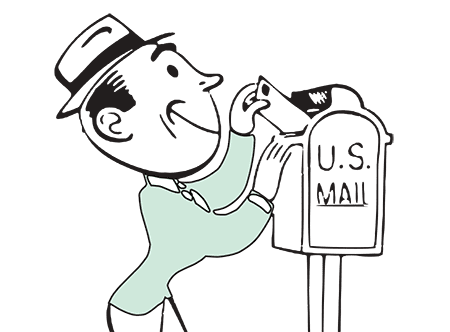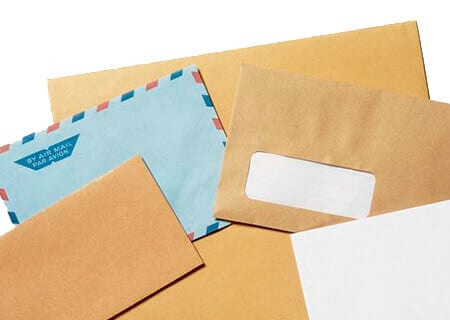Believe it or not, when it comes to a carbon footprint, your daily emails don’t have dainty feet. If you’re concerned about the environment, the best solution might be to think twice before going 100 percent digital. Email has a carbon footprint, too.
Me, You, and CO₂
But what does that mean, exactly? Let’s start with a science brush-up. A carbon footprint measures the amount of greenhouse gases released into the atmosphere during activities which support human life and industry. This is usually measured in metric tons of carbon dioxide, or CO₂. A certain amount of CO₂ has always been produced, not just by industry, as the emission of CO₂ is part of some natural processes. And our biosphere makes up for some of that by lending a certain amount of equilibrium. But the key, we’ve realized, is to avoid unnatural overload. Too much CO₂ can throw massive systems out of balance, including the weather, food supply chains, and geography. Rallying a response to this discovery is one of the hallmarks of our century.
Email vs. Trees
Going digital is another one of those hallmarks. And this is where our big question comes in. Paper obviously requires industry, which emits CO₂ through production and shipment. It also requires trees, which “breathe in” CO₂ and “breathe out” fresh oxygen. So, for a while, it seemed as if email, the new kid on the block, might replace paper as faster, more reliable, and more ecologically-sound. Emails don’t cut down trees. And you don’t throw emails in the wastebasket. Naturally, business owners have asked whether eliminating paper is the key to a new culture of sustainability.
But, wait a second. Like paper (which was once also a new technology), our computers have to come from somewhere. An email may seem disembodied and more efficient, but the Internet itself is supported by massive networks of interconnected machines which require manufacture and energy for operation. Our devices are also manufactured. And this has an impact. All these processes emit CO₂, and produce a carbon footprint. Even in digital communications, there’s no escaping a material cost. But how significant an effect does email have on the environment?
Energy, Industry, and Email
First, there’s the energy used to send and receive email. The servers and routers have to be manufactured and replaced. And then they use energy collecting, processing and transmitting our email. The data centers, which then store our emails and their attachments, also use energy. And these massive data centers are very active, creating a lot of heat, and need powerful air conditioners to keep from overheating. So, an email requires energy each time we write, send, store, move, reply, or delete. And researchers are starting to take note. Mike Berners-Lee, a sustainability and climate change expert, estimates in his book How Bad Are Bananas? The Carbon Footprint of Everything, that a single email can emit from 0.3 to 50 grams of CO₂ in transit, depending on the length and the size of attachments.
Okay, first we did science. Now for the math. Multiply this whole process by billions of emails around the world per day. If 200 billion emails is a modest estimate, our emails generate somewhere between 22 million and 4 billion metric tons (the equivalent of over 800 million cars) of CO₂ per year.
So, does email have a carbon footprint? Heck. Yes.
Another aspect is the sourcing of our devices. It’s hard to remember, but until the day we’ve got biodegradable computers (Is someone working on that?), our devices are not a renewable resource. The manufacture of paper has long been the object of attention for conservationists, and making sure we hang on to plenty of trees is a message that’s getting through loud and clear to business owners, thanks to more awareness and better regulations. But the tech industry hasn’t gotten there yet.
What does carbon footprint mean?
A carbon footprint measures the amount of greenhouse gases released into the atmosphere during activities which support human life and industry. This is usually measured in metric tons of carbon dioxide, or CO₂. Too much CO₂ can throw natural systems out of balance, including the weather, food supply chains, and geography.
The sourcing and assembly of email-sending devices are still much more complex, requiring non-renewable resources from around the world, many steps in production, and thousands of miles of shipping. The average iPhone, for example, begins its life in rare earth mineral mines in Mongolia. Parts are produced in Korea, Japan, Taiwan, and Switzerland, then assembled in China, before being shipped to the U.S. Sometimes entire factories overseas will close and new ones open at a frantic pace, as executives ask for last-minute adjustments, turning over jobs and using up resources. So, for each digital communication, it’s possible to trace a concrete, material cost to the environment as well as to the global economy.
Finding a Balance
We’ll leave it to the cost-benefit analyst among us to figure out the brightest future for electronic communications. They’re certainly not going anywhere. From doing good business with a client to sending funny cat videos, a lot of life happens through email.
But a lot of life still happens through paper, too. And not only are trees a renewable resource, paper is far easier than ever to reuse and recycle into new products. According to the latest marketing research, that’s good news, because the best way to reach out and build relationships is by combining digital with paper campaigns. Balance and creativity in your approach make a better impact than trying to establish an email-only relationship, not only in business terms but in ecological terms as well.
While it’s possible to replace paper, it’s not possible to replace the impact of a well-tailored paper campaign. And that starts with your envelope. For experience, knowledge, and craft, Letter Jacket has you covered. Check out our selection of fully customizable business envelopes today, and ask about free shipping on your first order.



